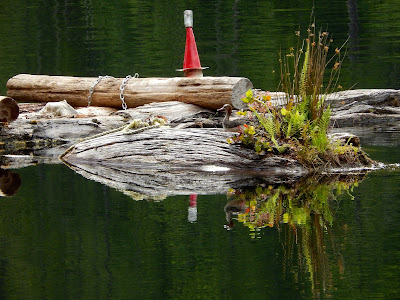 |
| Leaving Powell River on the North Island Princess |
Not far from Powell River is
Texada Island. It's
formed on a volcanic rock and limestone bed that was ground down during the ice age. With many visible outcroppings, it's nickname is
The Rock. Texada is 50 kilometres long, and has many forest service and logging roads. That makes it perfect for exploring by ATV.
We left Powell River on the
BC Ferries North Island Princess. She runs multiple times daily. Crossing takes about 35 minutes and it's a beautiful ride with views up and down the Straight of Georgia, Vancouver Island and occasional porpoise and whale sightings.
 |
| Camping in an old gravel pit reclaimed by millions of daisies. |
The population and several active quarries cluster on the
northern half of the island. The southern end is open land that has been logged periodically. That's where we headed. On the way through
Gillies Bay, we stopped at the
Ravenous Raven Lodge and Restaurant for dinner. It was an excellent way to start off a weekend getaway.
 |
| Riding a forest service road on Texada Island. |
At the end of paved Shelter Bay Road we turned right onto dirt surfaced Bell Road. Main dirt roads are in good shape with occasional potholes. Standard vehicles would have no trouble, but farther south 4X4 is necessary. Many of the
spur roads require an ATV, off-road bike, horse, or human foot power.
 |
| Signs point the way to Anderson Bay. |
At the junction of the forest service road we wanted there was a sign leading the way to Anderson Bay at the south end of the road. There's an old gravel pit past Second Lake, other wide spots along the road, or the recreation site at
Bob's Lake remote no service camping.
With full tummies, we set up camp and relaxed as the sun set behind the tall pines and firs. The next morning we offloaded our bikes and set out to explore.
 |
| Beautiful ponds and lakes abound. |
A
map from Powell River Tourism gave us the big picture. We continued south on the forest service road towards Anderson Bay. Until the final decent, it was fairly wide and rolling. I made it about half way down before I slowed my quad to a crawl. Wayne is a more advanced rider so he pressed on ahead.
 |
| Wayne on an old logging road overgrown with millions of daisies. |
We worked our way back to
Bob's Lake for a lunch break at a picnic table. No one was camping on such a nice summer weekend. In fact, over the 24-hour period we were camping and riding we only saw four vehicles and no other quad riders.
 |
| Bob's Lake forest remote recreation site. |
There are two main forest service branch roads heading south, Bell Road and Thompson Road. In between there are many old logging roads and a gas pipeline service route available to explore. We used the pipeline route just south of our campsite and joined a logging road that took us through some older growth trees to the east side of the mid-island ridge with ocean views across the Strait of Georgia to Vancouver Island.
 |
| Riding a section of the pipeline maintenance road. |
We connected with Thompson Road, headed south and reconnected with Bell Road. With impending showers cutting our camping short, we loaded our bikes, packed up and headed back to the ferry terminal at Blubber Bay. Named for its whaling history, it's now home to an Ash Grove Cement Company transfer site.
 |
| Historic concrete manufacture site at Blubber Bay. |
After putting our quads away, we headed to the
Costal del Sol in Powell River for some upscale Mexican food while the thunderstorms gathered and the rain began.
Here are some links for more information about Texada:
Texada Arts, Culture and Tourism Society
Texada Island Wikipedia
Texada Island Geology
Texada Island Maps
Texada Island Recreation Sites and Trails
Texada Island Events
Texada Island Accommodations
Ravenous Raven Lodge and Restaurant
BC Ferries
I invite you to visit Texada Island, whether or not you come to ride
The Rock. It has beaches, forests and anchorages galore. It's a place for quiet reflection, or active enjoyment -- something for everyone.
This story was also shared on my
Powell River Quad Rides blog and as a guest post
The Powtown Post. -- Margy
 In 2010, Wayne and I spotted a different kind of loon near our float cabin on Powell Lake. It had the same body shape and diving habits as a Common Loon, but the colours and sounds were just a bit off.
In 2010, Wayne and I spotted a different kind of loon near our float cabin on Powell Lake. It had the same body shape and diving habits as a Common Loon, but the colours and sounds were just a bit off. 









































































